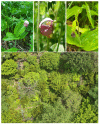Asymbiotic Seed Germination and In Vitro Seedling Development of the Endangered Orchid Species Cypripedium guttatum
- PMID: 38005685
- PMCID: PMC10675115
- DOI: 10.3390/plants12223788
Asymbiotic Seed Germination and In Vitro Seedling Development of the Endangered Orchid Species Cypripedium guttatum
Abstract
Cypripedium guttatum is a highly restricted terrestrial orchid that faces increasing endangerment owing to its habitat destruction and illegal collection. Compared to epiphytic orchids, terrestrial orchids such as C. guttatum have harder seed coats and more demanding in vitro germination conditions. This study aimed to develop an effective in vitro propagation system for C. guttatum to aid in its conservation. Seeds from mature capsules were subjected to various conditions, including sterilization using 1% sodium hypochlorite (NaOCl) and different light conditions, culture media, hormones, and organic supplements, to assess germination and early seedling development in vitro. Sterilization with 1% NaOCl significantly improved the germination rate, especially under dark conditions. Germination initiation occurred at 2 and 3 months in orchid seed sowing medium (OSM) and Murashige and Skoog (MS) medium, respectively. The addition of 1 mg/L naphthaleneacetic acid (NAA) further enhanced germination. However, the inclusion of organic supplements, such as apple and banana homogenates, in the culture medium led to substantial growth inhibition after 12 months. Notably, orchid maintenance medium (OMM) without organic additives proved to be the most suitable for seedling growth. The results of this study show that sterilization, appropriate light, and optimal NAA concentrations are beneficial for seed germination.
Keywords: Cypripedium guttatum; culture media; germination; light condition; organic supplementation; seeding growth.
Conflict of interest statement
The authors declare no conflict of interest.
Figures




Similar articles
-
Effect of Different Basal Media and Organic Supplements on In Vitro Seedling Development of the Endangered Orchid Species Dendrobium moniliforme (L.) Swartz.Plants (Basel). 2024 Sep 28;13(19):2721. doi: 10.3390/plants13192721. Plants (Basel). 2024. PMID: 39409591 Free PMC article.
-
Effects of Different Growth Media on In Vitro Seedling Development of an Endangered Orchid Species Sedirea japonica.Plants (Basel). 2021 Jun 11;10(6):1193. doi: 10.3390/plants10061193. Plants (Basel). 2021. PMID: 34208181 Free PMC article.
-
Asymbiotic seed germination and in vitro conservation of Coelogyne nervosa A. Rich. an endemic orchid to Western Ghats.Physiol Mol Biol Plants. 2012 Jul;18(3):245-51. doi: 10.1007/s12298-012-0118-6. Physiol Mol Biol Plants. 2012. PMID: 23814439 Free PMC article.
-
Mesoamerican Cypripedium: Mycorrhizal Contributions to Promote Their Conservation as Critically Endangered Species.Plants (Basel). 2022 Jun 12;11(12):1554. doi: 10.3390/plants11121554. Plants (Basel). 2022. PMID: 35736705 Free PMC article. Review.
-
Seed biology and in vitro seed germination of Cypripedium.Crit Rev Biotechnol. 2014 Dec;34(4):358-71. doi: 10.3109/07388551.2013.841117. Epub 2013 Nov 6. Crit Rev Biotechnol. 2014. PMID: 24191720 Review.
Cited by
-
Effect of Different Basal Media and Organic Supplements on In Vitro Seedling Development of the Endangered Orchid Species Dendrobium moniliforme (L.) Swartz.Plants (Basel). 2024 Sep 28;13(19):2721. doi: 10.3390/plants13192721. Plants (Basel). 2024. PMID: 39409591 Free PMC article.
References
-
- Chase M.W., Cameron K.M., Freudenstein J.V., Pridgeon A.M., Salazar G., Van den Berg C., Schuiteman A. An Updated Classification of Orchidaceae. Bot. J. Linn. Soc. 2015;177:151–174. doi: 10.1111/boj.12234. - DOI
-
- Willis K.J. State of the World’s Plants Report-2017. Royal Botanic Gardens; London, UK: 2017. - PubMed
-
- Seaton P.T., Hu H., Perner H., Pritchard H.W. Ex Situ Conservation of Orchids in a Warming World. Bot. Rev. 2010;76:193–203. doi: 10.1007/s12229-010-9048-6. - DOI
-
- Godo T., Komori M., Nakaoki E., Yukawa T., Miyoshi K. Germination of Mature Seeds of Calanthe tricarinata Lindl., an Endangered Terrestrial Orchid, by Asymbiotic Culture in Vitro. Vitr. Cell. Dev. Biol.-Plant. 2010;46:323–328. doi: 10.1007/s11627-009-9271-1. - DOI
-
- Warcup J. Symbiotic Germination of Some Australian Terrestrial Orchids. New Phytol. 1973;72:387–392. doi: 10.1111/j.1469-8137.1973.tb02046.x. - DOI
Grants and funding
LinkOut - more resources
Full Text Sources

